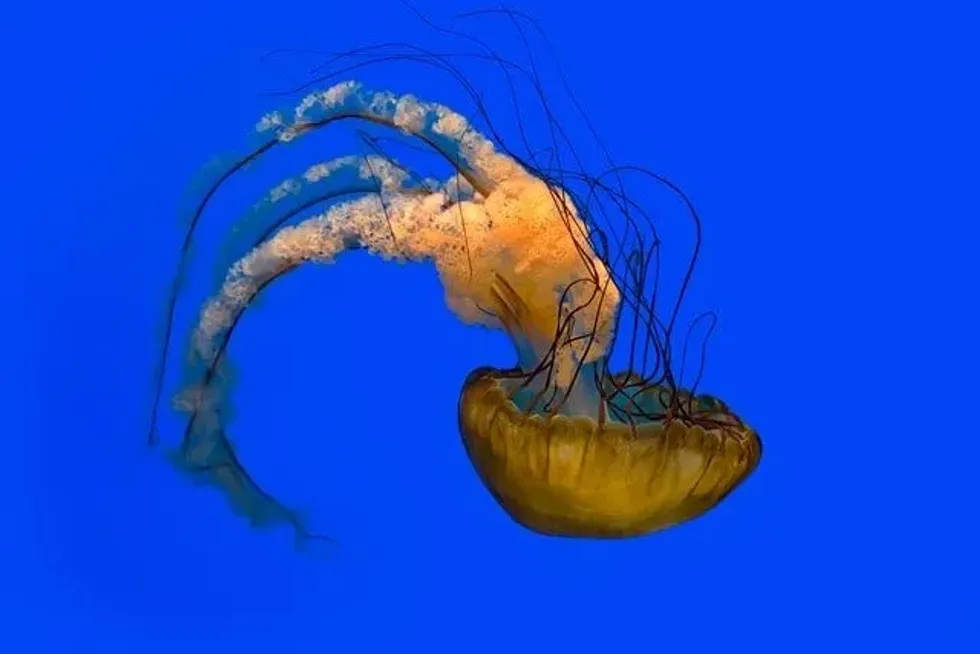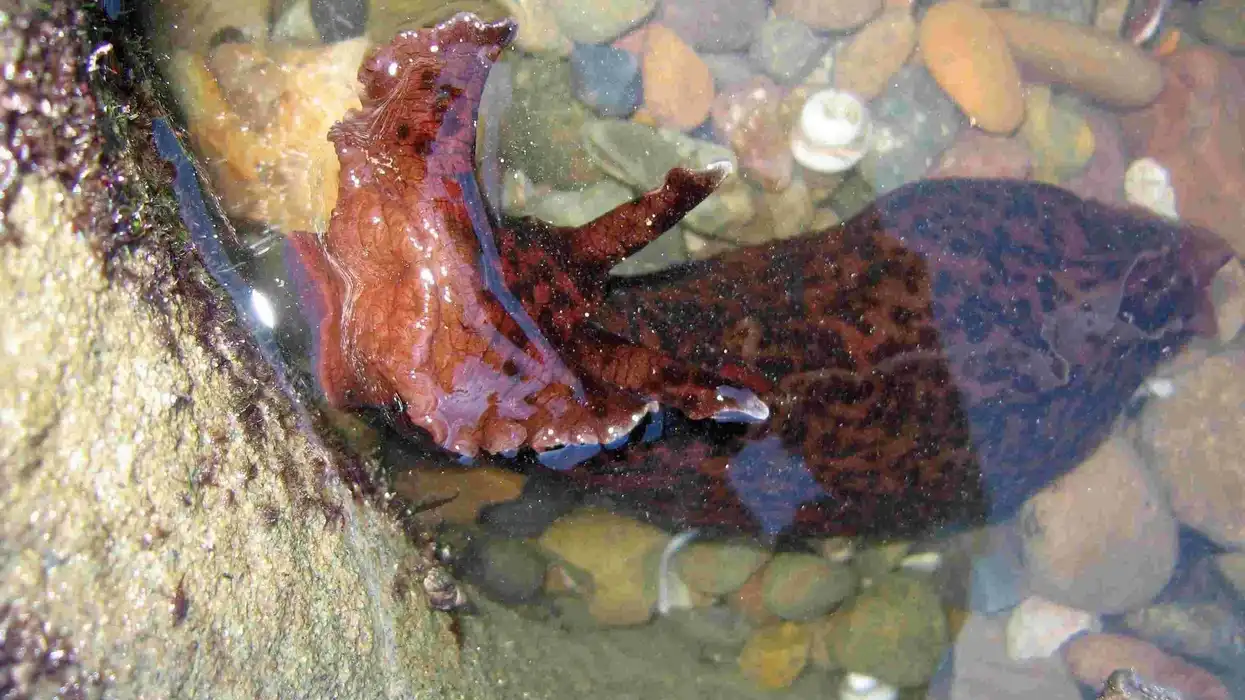Do you know about the ocean creatures looking like floating dream catchers? With long oral arms and tentacles and a bell-shaped stout head, sea nettles (Chrysaora quinquecirrha) are a unique species of jellyfish.
Found swimming on the surface waters of the Chesapeake Bay or deep under the Atlantic or Pacific ocean, they have a unique swimming style underwater.
With their oral arms, they take in and hold back water in their head, and spray it out in jets to move forward or backward linearly using their tentacles.
They mostly move opposite to the direction of ocean currents and swim 24 hours a day in their saline habitat. While small fish and crustaceans are their food, the sea nettles get preyed upon by sea turtles.
Enjoying reading about these wobbly sea creatures? Read on to know more interesting east coast or Atlantic sea nettle and west coast sea nettle jellyfish facts.
Know more interesting facts about immortal jellyfish and sea squirts here.
Sea Nettle Interesting Facts
What type of animal are Sea Nettles?
Sea nettles are a species of jellyfish found in the saline marine habitat.
What class of animal do Sea Nettles belong to?
Sea nettle jellyfish belong to the class of Scyphozoa. The body of a sea nettle is radial in symmetry.
How many Sea Nettles are there in the world?
At present, humans have not been able to track or record the actual number of comb jellies present in the world's oceans.
Where do Sea Nettles live?
The sea nettle jellyfish species live in the marine waters. They are found in plenty in the pelagic ocean environment of the tropical and sub-tropical waters.
What is a Sea Nettle's habitat?
These animals are found along the coast of North America. On the east coast Atlantic sea nettle and on the west coast the Pacific sea nettle is found. Their maximum population hovers around the Chesapeake Bay and the Gulf of Mexico.
Who do Sea Nettles live with?
Sea nettle's (both Atlantic sea nettle and Pacific sea nettle) prefer to live on their own in times of hunting for fish and other food. Also to nest their fertilized eggs, these jellies prefer a distant and isolated spot in the deep water. These jellyfish come together in packs to attack predator species and other enemies.
How long do Sea Nettles live?
On average, the lifespan of these comb jellies (Chrysaora quinquecirrha) ranges between six and 18 months in conservation aquariums. While they live for six months to a year in the wild.
How do they reproduce?
This species of jellyfish is capable of reproducing both sexually and asexually. The young sea nettles, or polyps, can reproduce asexually while sexual reproduction is done by the adults in their medusa stage.
However, no specific mating pattern has been identified between the male and the female jellies. In a single day, they lay over 40,000 eggs which hatch into larvae within three hours.
These larvae swim to attach themselves to a solid platform for further growth into polyps.
Soon after this, they grow their tentacles and oral arms and take the shape of a medusa (jellyfish form). The male and female nettle can then develop their reproductive organs, after which they become sexually mature enough to reproduce.
The male jellies ejaculate their sperms from the tentacles into the bell-shaped mouth of the female nettle. They hold the sperm and fertilized eggs in their mouth until it matures and develops into polyps.
What is their conservation status?
The populations of all the species of sea nettles like the Atlantic Sea nettle and the Pacific sea nettle are not yet evaluated by the IUCN. It is assumed that there are plenty of these comb jellies that are there in the ocean waters.
However, there has been an increasing concern over the overwhelming population growth of the sea nettles at the expense of other animals in the marine ecosystem.
This is occurring because a major portion of their diet consists of larval fish and crustaceans which hold economic value for humans.
So these jellies are not listed as an endangered species as of now. Their population around the Chesapeake Bay and Pacific ocean is on a constant rise but they drift to other places during winters when the temperature of the water drops.
Sea Nettle Fun facts
What do Sea Nettles look like?

Sea nettles are radially symmetrical ranging from 16-20 inches in diameter. Since they are a species of jellyfish, their bodies resemble that of other jellyfish.
They have a bell-shaped head and long arms and tentacles attached at the base of their head. The bell grows almost 6-8 inches in diameter, and their oval arms and tentacles up to 20 inches in diameter. The body of these jellies is translucent and opaque with reddish stripes and black spots.
How cute are they?
The wobbling oral arms with their saucer-like head make them sea nettle jellyfish a unique species. It is bizarre to call these ocean jellyfish species to be cute.
But considering their oval body with a big bell head and long tentacles, one may find them to be cute when displayed in aquariums. If we have to quantify their cuteness on a scale of one to 10, a sea nettle (Chrysaora quinquecirrha) can be rated a three.
How do they communicate?
Although not much is known about this species of sea nettles (Chrysaora quiquecirrha), there are some noticeable behaviors observed. The sea nettles communicate with a variety of ocean species in different ways.
In order to swim around freely in the ocean waters, they use their bell head for spraying jets of water and arms and tentacles for taking strokes.
For obtaining food for their diet, they prey on other fish by first attacking and injecting venom into the body of the fish. Soon after this, the fish are paralyzed, and then using their oral arms they gulp the prey in.
For driving away predators like big fish, sea turtles, and other species of jellies, they assemble together and start stinging and injecting venom into the bodies of their predators.
During the breeding months, populations of male and female jellies move around in the open ocean or bay for sexual reproduction. Their interaction with humans is also not friendly as a sea nettle sting causes allergies and low-intensity discomfort to humans.
How big are Sea Nettles?
The size of a sea nettle jellyfish ranges from 16 to 20 inches in diameter. They are twice as big as a starfish and eight times smaller than a dolphin.
How fast can Sea Nettles move?
The exact speed of a sea nettle's movement in the ocean is unknown. But they are fast swimmers because of their long tentacles and move over large distances in water in no time.
How much do Sea Nettles weigh?
While several other sea nettle jellyfish fun facts are known, the weight of this species of wobbly jellies is unknown.
What are their male and female names of the species?
There are no specific or separate names assigned to the sea nettles. This holds true for both the South Pacific sea nettle and Atlantic Ocean sea nettle.
What would you call a baby Sea Nettle?
Right after the eggs of these jellies hatch, they are called larvae. After some time these larvae grow into baby polyps of jellyfish. The adult stage of this species is called medusa.
What do they eat?
The diet of a sea nettle consists of food like small fish, fish eggs and larvae, zooplanktons, sea snails, and other crustaceans. To obtain their prey, they sting, inject venom from their tentacles, and immobilize their prey. Thereafter, using their oral arms they put the food into their mouth.
Are they dangerous?
The species of sea nettle jellyfish are not dangerous to human beings. They might sting humans to defend themselves causing a temporary rash on the skin.
But this ocean animal is very a dangerous predator capable of killing its prey within seconds. The tentacles have venom-filled onto them which pricks into the body of the prey and paralyzes and kills them in no time.
Would they make a good pet?
This species of jellyfish (Chrysaora quinquecirrha) can only survive in the salty ocean water at specific zones like in the Chesapeake Bay of the South Pacific Ocean and near the US Atlantic Ocean coast. They cannot be domesticated and kept as pets at home. But several national aquariums have delved into ex-situ conservation and displaying them to visitors.
Did you know...
The sea nettle spends almost 24 hours a day swimming around in the ocean water. It never rests and is always on the go.
Animals like crabs use sea nettles as a means of transportation from the water to the seashore. The young crabs attach themselves to the tentacles and sometimes also feed on the carrier sea nettle when hungry.
The breeding season of the sea nettles in the summer months.
The cold Atlantic and Pacific ocean and Chesapeake Bay waters restrict them from inhabiting their usual habitats during the winters, hence they migrate over long distances.
Eyespots are present in the bottom of the head of the sea nettles in the medusa stage, enabling them to sense light and dark surfaces in the ocean.
The Pacific sea nettle is showcased in the aquarium of the Northern Pacific Gallery.
Populations of all sea nettles are extremely important to keep up the oceanic homeostasis. They suck in oceanic waste as their food which helps in clearing the ocean and bay water all over the world.
Different types of Sea Nettle
There are numerous species of sea nettles present in the ocean, bay, near coasts, etc.
All these invertebrate populations of sea nettle are found in various locations of the world. While there are only variations in color and size, the behavioral characteristics of all the jellies are the same.
The 15 subspecies are black sea nettles, Chrysaora africana, Chrysaora chesapeakei (found in Barnegat Bay and coastal waters of New Jersey, Chrysaora chinensis, the purple-striped jelly, Chrysaora fulgida, Pacific sea nettle, Chrysaora helvola, Chrysaora lactea, Chrysaora pentastoma, Compass jellyfish, Northern sea nettles, Japanese sea nettles, South American sea nettles, and Atlantic sea nettles.
How do Sea Nettles reproduce?
One of the interesting sea nettle jellyfish facts is that they are capable of both sexual and asexual reproduction. At the immature polyp stage, asexual reproduction occurs among the nettle populations.
After maturing into a medusa, nettles like the black sea nettle, Pacific sea nettle, Atlantic sea nettle, etc, reproduce sexually.
The males release their sperm in the oral arms of the females, the eggs remain attached to the female tentacles. The eggs fertilize in these oral arms and the larvae are released from the tentacles which attach themselves to a solid surface in the ocean.
Here at Kidadl, we have carefully created lots of interesting family-friendly animal facts for everyone to discover! Learn more about some other arthropods including fire coral and brain coral.
You can even occupy yourself at home by drawing one of our easy jellyfish coloring pages.









